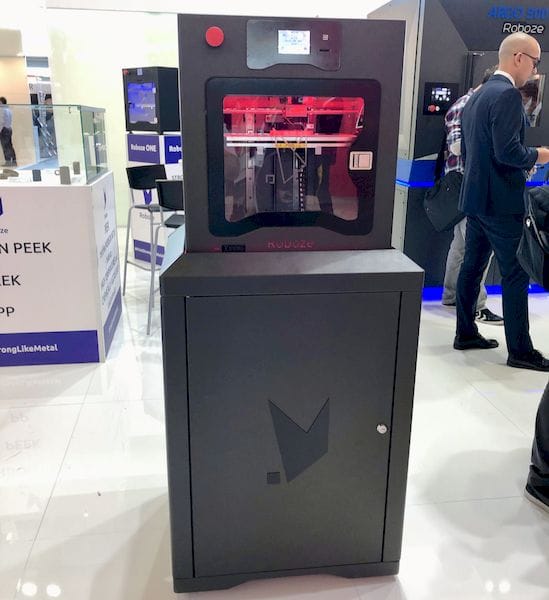![The new Roboze Xtreme series of high-temperature 3D printers [Source: Fabbaloo]](https://fabbaloo.com/wp-content/uploads/2020/05/image-asset_img_5eb0a08422f51.jpg)
Roboze has been growing significantly in the past year.
The Italian company began several years ago by introducing a straightforward desktop 3D printer capable of printing with high-temperature materials, which at the time was a rarity. That’s less true today, with several options available in the market. However, Roboze has gone on to introduce several new machines with added features, and one offering very large build volumes for production 3D printing.
Recently they upgraded their intermediate machine line, which they call “Xtreme”.
The new machine line is based on their previous models, but includes a number of internal changes that should benefit speed, reliability and print quality.
The Xtreme series includes a better rack and pinion motion system that enables accuracy of only 15 microns (and only 10 on their huge Argo 500 machine). There is also a speed advantage, with the new motion system allowing up to 4000mm/min. This is 20% more than their previous system.
I should point out that Roboze is one of the only companies using a rack and pinion motion system. This is because the more common belt-driven approach is not optimal when 3D printing high-temperature materials: the build chamber must be heated, and this would expose the belt material itself to that same heat and could compromise its consistency.
The electronics in the Xtreme series are also improved. There is now encoder feedback from motors that allows their software to better control activities in real time. They’ve also replaced the mechanical endstops that tell the system that a motion system has hit the end of its path. They are now touchless, which should require less maintenance and allow for faster operations.
![Terrific details on this sample 3D print from Roboze [Source: Fabbaloo]](https://fabbaloo.com/wp-content/uploads/2020/05/image-asset_img_5eb0a0847ae75.jpg)
A very interesting added feature is a vacuum plate system. This allows a special sheet of suitably adhesive material to be placed on the print plate and receive the print. It’s held down securely by a vacuum system that is hidden in the lower portion of the machine.
There are many advantages to this approach. First, it allows very quick changeover: when a print completes, pull out the sheet with prints attached and quickly load another sheet to continue printing. Secondly, the sheet can be made from different materials, so you can theoretically select the correct adhesion solution for a given material. Note that this approach is precisely what Stratasys uses for their Fortus series, and it’s been quite successful for many years.
The system also apparently includes a filament dryer, which will be quite important for 3D printing nylons. That material can very quickly degrade when exposed to atmospheric moisture, which it absorbs rapidly.
These new features allow the Xtreme series to 3D print in a wider array of high-temperature materials, including PP-CF, PA-Glass, carbon fiber composites and more.
There are two models of the Xtreme series at the moment, the Roboze One Xtreme , priced at €25K (US$28.5K) and the Roboze One Plus Xtreme (which allows higher-temperature materials), priced at €70K (US$80K).
![Another sample 3D print from Roboze [Source: Fabbaloo]](https://fabbaloo.com/wp-content/uploads/2020/05/image-asset_img_5eb0a084c66ff.jpg)
That’s not all.
Roboze has just announced an important funding arrangement. They have received a huge €3M (US$3.5M) investment from Equiter SPA, which seems to be a fund operated by a major European investment bank.
The new funds demonstrate that investors believe in Roboze’s products and market. Roboze says they will use the funds to dramatically expand their operations. In fact, they say they wish to quintiple their sales and hire “up to” 80 new employees in the next 18 months.
This is a very significant boost and should propel Roboze to one of the leading providers of high-temperature 3D printers and related services.
Via Roboze











FELIXprinters has released a new bioprinter, the FELIX BIOprinter, which is quite a change for the long-time 3D printer manufacturer.